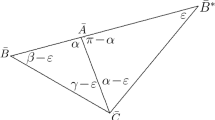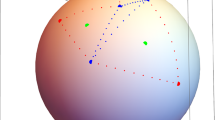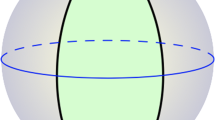Abstract
Relations of circumradius, inradius and the distance between the circumcenter and incenter of Euclidean bicentric polygons are generalized into spherical geometry and hyperbolic geometry. The asymptotic behavior of these generalized formulas with small circumradius are studied. Relations for hyperbolic hyper-ideal bicentric polygons are derived.
Similar content being viewed by others
Avoid common mistakes on your manuscript.
1 Introduction
1.1 Euclidean bicentric polygons
Given a Euclidean triangle, its circumradius R, inradius r, and the distance d between its circumcenter and incenter satisfy the relation
This formula was discovered by William Chapple in 1746 [1] and by Leonhard Euler in 1765 [2, 3].
A bicentric polygon is a polygon with all vertices on a circle, called the circumcircle, and all sides tangent to another circle, called the incircle.
Given a Euclidean bicentric quadrilateral, its circumradius R, inradius r, and the distance d between its circumcenter and incenter satisfy the relation
This formula was discovered by Nicolaus Fuss in 1797 [4].
Given a Euclidean bicentric convex pentagon, its circumradius R, inradius r, and the distance d between its circumcenter and incenter satisfy the relation [5, 6]
Equivalent forms of this formula were discovered by Nicolaus Fuss in 1802 [7] and Jakob Steiner in 1827 [8].
For a self-intersecting bicentric pentagon, the relation ((3.15) in [9]) is
More about the history of these formulas and their relation with Poncelet’s closure theorem [10] can be found in [11,12,13,14,15,16].
1.2 Hyperbolic bicentric polygons
Alabdullatif [17] generalized Chapple’s formula and Fuss’ formula into hyperbolic geometry. Given a hyperbolic triangle, its circumradius R, inradius r, and the distance d between its circumcenter and incenter satisfy the relation
Given a hyperbolic bicentric quadrilateral, its circumradius R, inradius r, and the distance d between its circumcenter and incenter satisfy the relation
where \(s(x)=\sinh x\) and \(c(x)=\cosh x.\)
The two formulas are derived by using Poncelet’s closure theorem in hyperbolic geometry which is established in [17]. Poncelet’s closure theorem for the hyperbolic plane (and general hyperbolic space) was first established in [18].
For a hyperbolic bicentric n-gon, the relation between its circumradius R, inradius r, and the distance d between its circumcenter and incenter is also derived in [17] using hyperbolic trigonometry.
After checking that, when R approaches 0, Chapple’s formula (or Fuss’ formula) appears as a factor of the lowest order terms of its hyperbolic analogue, Alabdullatif [17] conjectured that this holds for any bicentric n-gon.
Conjecture 1
(Alabdullatif, 2016) Let C and D be two disjoint circles in the hyperbolic plane, with D inside C. Let R denote the radius of C, r denote the radius of D and d denote the distance between the two circles’ centres. Assume that there is a bicentric embedded n-gon between them, then, we can write the hyperbolic general formula as \(f_n(R, r, d) = 0\), by using the expressions
for R small, \(x=R,r,d,R+d,...,R+d+r,\) such that
where \(g_i(R,r,d)\) is homogeneous of order i, then the lowest order non zero \(g_i\) has the Euclidean version as a factor.
1.3 Spherical and hyperbolic triangles
Cho and Naranjo [19] generalized Chapple’s formula into spherical geometry and hyperbolic geometry and derived a unified formula for the three geometries.
The three equations can be unified as
where
as defined in [20].
And K is the curvature,
1.4 Main results
In this paper, given a spherical or hyperbolic bicentric polygon, a relation between its circumradius R, inradius r, and the distance d between its circumcenter and incenter is derived. This relation is derived by using a different method and expressed in a different form from [17].
Define
Theorem 2
In Euclidean, hyperbolic or spherical geometries, given two circles with radius R and r, let d be the distance between the centers of the two circles. Suppose \(R>r+d\). There exists an n-gon inscribed in the circle with radius R and circumscribed about the circle with radius r if and only if \(d_*, r_*\) and \(R_*\) satisfy the polynomial equation \(U_n^{(K)}(d_*, r_*, R_*)=0\).
Inspired by Alabdullatif’s conjecture, we study the behavior of \(U_n^{(K)}\) when R is small.
Theorem 3
In hyperbolic or spherical geometry, when R approaches 0, using \(x_*\simeq x\) for \(x=d, r, R\), \(U_n^{(\pm 1)}(d_*, r_*, R_*)\) is written in terms of d, r, R. Then its homogeneous part with the lowest degree equals \(U_n^{(0)}(d, r, R)\).
Let \(l_1,l_2,...,l_n\) be n mutually disjoint geodesics in the hyperbolic plane. For each pair \(\{l_i,l_{i+1}\}\) (where \(n+1\equiv 1\)), there is a unique geodesic segment \(P_i\) orthogonal to both \(l_i\) and \(l_{i+1}\), and the length of the segment realizes the distance between \(l_i\) and \(l_{i+1}\). The region with finite area bounded by the geodesics \(l_1,l_2,...,l_n\) and \(P_1,P_2,...,P_n\) is a hyperbolic hyperideal polygon.
A hyperbolic hyperideal polygon is bicentric if there exists a hyperbolic circle tangent to \(P_1, P_2,..., P_n\) and a hyperbolic circle tangent to \(l_1, l_2,..., l_n\).
Theorem 4
Given two hyperbolic circles with radius R and r respectively, there exists a bicentric hyperbolic hyperideal n-gon whose sides are tangent to the two circles if and only if \(U_n^{(-1)}(d_*, r_*, R_*^{-1})=0\). And the polynomial \(U_n^{(-1)}(d_*, r_*, R_*^{-1})\) is symmetric in r and R.
1.5 Organization of the paper
In Sect. 2, the main tool, Cayley’s conditions, is recalled. In Sect. 3, Cayley’s conditions are used to derive the unified formulas. In Sect. 4, the asymptotic behavior of the formulas in hyperbolic and spherical geometries are studied when R is small. In Sect. 5, formulas for bicentric hyperbolic hyperideal polygons are derived.
2 Cayley’s conditions
Arthur Cayley first found in 1853 [21, 22] explicit conditions determining, for two given conics, the existence of an n-gon inscribed in one and circumscribed about the second conic. These conditions were republished in 1861 [23, 24] in a more complete form. More about the history and modern proofs of Cayley’s conditions can be found in [12,13,14,15, 25].
Theorem 5
[Cayley, 1861] Let \(C[x,y,z]=0\) and \(D[x,y,z]=0\) be the homogeneous quadratic equations in projective coordinates that define suitable conics C and D.
Let Q(t)be the \(3\times 3\) symmetric matrix of the quadratic form \(tC[x,y,z]+D[x,y,z]\) and let \(A_i\) be defined by
Let \(n\ge 3.\) There exists an n-gon inscribed in C and circumscribed about D if and only if
2.1 Examples [5, 6]
Let
be two circles in the Euclidean plane.
The corresponding homogeneous polynomials are
Then
Now let \(E_n, n\ge 0,\) denote the coefficients in the case of Euclidean geometry, i.e.,
Then \(E_n, n\ge 0,\) can be determined. For example,
In general, each
where \(t_n\) is a power of 2 and \(T_n(d,r,R)\) is a homogeneous polynomial of degree 2n in terms of d, r and R.
Cayley’s condition for the existence of a triangle inscribed in the first circle and circumscribed about the second circle is \(E_2=0\) which is equivalent to Chapple’s formula \(R^2-d^2=2rR.\)
Cayley’s condition for the existence of a bicentric quadrilateral inscribed in the first circle and circumscribed about the second circle is \(E_3=0\) which is equivalent to Fuss’ formula \((R^2-d^2)^2=2r^2(R^2+d^2).\)
Cayley’s condition for the existence of a bicentric pentagon inscribed in the first circle and circumscribed about the second circle is \(E_2E_4=E_3^2\) which is equivalent to
which contains Fuss and Steiner’s formula for a convex bicentric pentagon and the formula for a self-intersecting bicentric pentagon.
3 Unified formulas
Cayley’s type conditions corresponding to Poncelet’s closure theorem for the hyperbolic plane (and general hyperbolic space) were derived in [18]. The following proof investigates some concrete examples of the general theory in [18].
Proof of Theorem 2
Step 1. In the unit sphere \(\mathbb {S}^2 \subset \mathbb {R}^3\) defined by \(x^2+y^2+z^2=1\), consider the first circle in \(\mathbb {S}^2\) with center (0, 0, 1) and radius R (measured by the spherical metric). It is the intersection of \(\mathbb {S}^2\) with the cone in \(\mathbb {R}^3\) defined by
Consider the second circle in \(\mathbb {S}^2\) with center \((0,\sin d, \cos d)\) and radius r. It is the intersection of \(\mathbb {S}^2\) with the cone defined as follows.
Let (x, y, z) be a point on the cone. It also denotes the vector from (0, 0, 0) to this point. The angle between the vector (x, y, z) and the vector \((0,\sin d, \cos d)\) is r. Then

Step 2. Let \((x_1,y_1,z_1)\) and \((x_2,y_2,z_2)\) be two vectors in \(\mathbb {R}^3\). The Lorentzian inner product is defined as
The Lorentzian norm of (x, y, z) is
The hyperboloid model of the hyperbolic plane is
Consider the first circle in \(\mathbb {H}^2\) with center (0, 0, 1) and radius R (measured by the hyperbolic metric). It is the intersection of \(\mathbb {H}^2\) with the cone defined as follows [26].

Consider the second circle in \(\mathbb {H}^2\) with center \((0,\sinh d, \cosh d)\) and radius r. It is the intersection of \(\mathbb {H}^2\) with the cone defined as follows.

Step 3. A unified formula is derived in terms of the function \(x_*\) and the curvature K.
In spherical, Euclidean or hyperbolic geometries, consider the two circles with radius R and r and the distance between their centers is d. The corresponding cones are
The second one is equivalent to
Then by Cayley’s conditions,
Now
where
After finding \(A_n, n\ge 0,\) Cayley’s conditions can produce unified formulas in terms of \(d_*, r_*, R_*\) and K. Corresponding to \(K=0,\) the relations are exactly the ones in Euclidean geometry. \(\square \)
For example, comparing the coefficients of \(t^n, n=0,1,2,3\), we have
Cayley’s condition for the existence of a triangle inscribed in the first circle and circumscribed about the second circle is
Cayley’s condition for the existence of a bicentric quadrilateral inscribed in the first circle and circumscribed about the second circle is
In Euclidean geometry, it becomes
4 Asymptotic behavior when R is small
Proof of Theorem 3
In the case of hyperbolic geometry, where \(K=-1,\)
Comparing with the expansion in the case of Euclidean geometry, we have
where \(T_n\) is the homogeneous polynomial in the formula (1) of \(E_n\) the coefficients in Euclidean geometry and \(\lambda _n\) is a polynomial in terms of \(d_*,r_*\) and \(R_*\) with the lowest degree \(2n+2, n\ge 1\).
When R is small, then r, d are small, therefore \(d_*, r_*, R_*\) are small and approximately equal to d, r, R respectively. By ignoring the term with degree greater than 1, we have
Therefore the lowest term in a relation of \(H_i\)’s determined by Cayley’s conditions is a relation of \(E_i\)’s determined by the same conditions.
The same arguments work for spherical bicentric polygons. \(\square \)
5 Hyperideal
Proof of Theorem 4
Let (x, y, z) be a space-like vector in \(\mathbb {R}^3\), i.e., satisfying \(||(x,y,z)||>0.\) Consider the set of all vectors in \(\mathbb {R}^3\) Lorentz orthogonal to (x, y, z):
which is a plane passing through (0, 0, 0). Its intersection with the hyperboloid model \(\mathbb {H}^2\) is a geodesic P in \(\mathbb {H}^2\).
A cone is obtained by rotating the ray in the direction (x, y, z) about the z-axis. The equation of the cone is

where R is the distance form the point (0, 0, 1) to the geodesic P (Theorem 3.2.12 in [26]).
As in the case of hyperbolic polygons, the circle in \(\mathbb {H}^2\) with center \((0,\sinh d, \cosh d)\) and radius r is the intersection of \(\mathbb {H}^2\) with the cone defined by
The intersections of the two cones with the plane defined by \(z=1\) are a circle and an ellipse. For a fixed integer \(n\ge 3\), Cayley’s conditions are satisfied if and only if there exists a Euclidean n-gon inscribed in the circle and circumscribed about the ellipse. The i-th side of the Euclidean polygon determines a plane \(L_i\) passing through (0, 0, 0) and this side. The intersection of \(L_i\) with \(\mathbb {H}^2\) is a geodesic \(l_i\) tangent to the hyperbolic circle with center \((0,\sinh d, \cosh d)\) and radius r.
Let \((x_i,y_i,z_i)\) be the vector from (0, 0, 0) to the vertex of the Euclidean polygon incident with the i-th side and \((i+1)\)-th side (where \(n+1\equiv 1\)). Then \((x_i,y_i,z_i)\) is a space-like vector and it determines a geodesic \(P_i\) in \(\mathbb {H}^2\) whose distance to the point (0, 0, 1) is R, and is therefore tangent to the hyperbolic circle with center (0, 0, 1) and radius R. And \(P_i\) is orthogonal to the two geodesics \(l_i\) and \(l_{i+1}\). Then \(\{l_1,\dots ,l_n\}\) together with \(\{P_1,\cdots ,P_n\}\) bound a hyperbolic hyperideal polygon.
Since each \(P_i\) is tangent to a hyperbolic circle and each \(l_i\) is tangent to another hyperbolic circle, this hyperideal polygon is bicentric.
Comparing the two cones in this case with the two cones in the case of hyperbolic polygons, we can see that once a relation of d, R and r of a hyperbolic bicentric polygon is obtained, a relation of d, R and r of a hyperbolic hyperideal bicentric polygon can be derived by replacing \(\tanh R\), \(\sinh R\) and \(\cosh R\) by \(\tanh ^{-1}R\), \(i\cosh R\) and \(i\sinh R\) respectively.
And the formula for a hyperbolic hyperideal polygon is symmetric in R and r, because the difference between a circumcircle and an incircle does not exist in this case. \(\square \)
For example, from the relation for a hyperbolic triangle, we get the relation for a hyperbolic hyperideal triangle:

The relation for a hyperbolic hyperideal bicentric quadrilateral is
where \(x_*=\tanh x\).
Data availability
No datasets were generated or analysed during the current study.
References
Chapple, W.: An essay on the properties of triangles inscribed in, and circumscribed about two given circles. Gentlemen’s Mag. Misc. Curiosa Math. 4, 117–124 (1746)
Euler, L.: Solutio facilis problematum quorundam geometricorum difficillimorum. Novi Comm. Ac. Sci. Imp. Petropolitanae XI: 103-123
Euler, L.: Opera Omnia. Leipzig: ser. I 26(139–157), 1765 (1911)
Fuss, N.: De quadrilateris quibus circulum tam inscribere quam circumscribere licet. Nova acta Ac. Sci. Imp. Petropolitanae 10, 103–125 (1797)
Cayley, A.: Developments on the Porism of the in-and-circumscribed Polygon. Philosophical Magazine S. 4(7), 339–345 (1854)
Cayley, A.: The Collected Mathematical Papers of Arthur Cayley, vol. 2, pp. 138–144. Cambridge University Press, Cambridge pp (1889)
Fuss, N.: De polygonis symmetrice irregularibus circulo simul inscriptis et circumscriptis. Nova acta Ac. Sci. Imp. Petropolitanae 13, 166–189 (1802)
Steiner, J.: Aufgaben und Lehsätze (n. 57). Journal für die reihe und Angewandte Mathematik 2: 289, (1827)
Radić, M., Zatezalo, A.: About some kinds of bicentric polygons and concerning relations. Math. Maced. 4, 47–73 (2006)
Poncelet, J.-V.: Traité sur les propriétés projectives des figures, Paris: Bachelier; 2nd edition 1865–66. Gauthier-Villars, Paris (1822)
Bos, H.J.M., Kers, C., Oort, F., Raven, D.W.: Poncelet’s closure theorem. Exposition. Math. 5(4), 289–364 (1987)
Del Centina, A.: Poncelet’s porism: a long story of renewed discoveries, I. Arch. Hist. Exact Sci. 70(1), 1–122 (2016)
Del Centina, A.: Poncelet’s porism: a long story of renewed discoveries, II. Arch. Hist. Exact Sci. 70(2), 123–173 (2016)
Dragović, V., Radnović, M.: Poncelet porisms and beyond. Front. Math. Birkhäuser/Springer Basel AG, Basel (2011)
Dragović, V., Radnović, M.: Bicentennial of the great Poncelet theorem (1813-2013): current advances, Bull. Amer. Math. Soc. (N.S.) 51(3), 373–445 (2014)
Flatto, L.: Poncelet’s theorem. American Mathematical Society, Providence, RI (2009)
Alabdullatif, A.: Hyperbolic Variants of Poncelet’s Theorem, PhD Thesis, University of Southampton, (2016)
Dragović, V., Jovanović, B., Radnović, M.: On elliptic billiards in the Lobachevsky space and associated geodesic hierarchies. J. Geom. Phys. 47(2–3), 221–234 (2003)
Cho, K., Naranjo, J.: Extensions of Euclidean Relations and Inequalities to Spherical and Hyperbolic Geometry, REU Proceedings, Oregon State University, (2017)
Guo, R., Sönmez, N.: Cyclic Polygons in Classical Geometry, C.R. Acad. Bulgare Sci., 64(2),(2010)
Cayley, A.: Note on the Porism of the in-and-circumscribed Polygon. Philosophical Magazine S. 4(6), 99–103 (1853)
Cayley, A.: The Collected Mathematical Papers of Arthur Cayley, vol. 2, pp. 87–90. Cambridge University Press, Cambridge pp (1889)
Cayley, A.: On the Porism of the in-and-circumscribed Polygon. Philos. Trans. R. Soc. Lond. 151, 225–239 (1861)
Cayley, A.: The Collected Mathematical Papers of Arthur Cayley, vol. 4, pp. 292–308. Cambridge University Press, Cambridge pp (1891)
Griffiths, P., Harris, J.: On Cayley’s explicit solution to Poncelet’s porism. Enseign. Math. 24(1–2), 31–40 (1978)
Ratcliffe, J.G.: Foundations of hyperbolic manifolds. Second edition, Grad. Texts in Math., 149, Springer, New York, (2006)
Acknowledgements
The author extends gratitude to the referees for their meticulous review of the manuscript and invaluable feedback. Special acknowledgment is given for drawing attention to the paper [18].
Author information
Authors and Affiliations
Contributions
R.G. conducted the research and wrote the manuscript.
Corresponding author
Ethics declarations
Conflict of interest
The authors declare no Conflict of interest.
Additional information
Publisher's Note
Springer Nature remains neutral with regard to jurisdictional claims in published maps and institutional affiliations.
Rights and permissions
Springer Nature or its licensor (e.g. a society or other partner) holds exclusive rights to this article under a publishing agreement with the author(s) or other rightsholder(s); author self-archiving of the accepted manuscript version of this article is solely governed by the terms of such publishing agreement and applicable law.
About this article
Cite this article
Guo, R. Spherical and hyperbolic bicentric polygons. Aequat. Math. (2024). https://doi.org/10.1007/s00010-024-01088-8
Received:
Revised:
Accepted:
Published:
DOI: https://doi.org/10.1007/s00010-024-01088-8
Keywords
- Bicentric polygons
- Poncelet’s closure theorem
- Spherical polygons
- Hyperbolic polygons
- Hyper-ideal polygons




